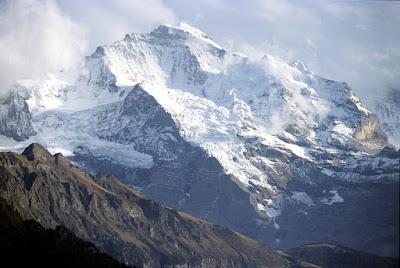Naming mountains after people can lead to unforeseen complications
By and large, naming summits after people is not something that I can favour. I feel that it is presumptuous of our generation to associate our fleeting lives with mountains that are hundreds of thousands of years older than we are, and that will outlive us by an equal span.
 |
| At the Hotel des Neuchatelois: where mountains were named after people Illustration by Paul Hertig, Biel |
Two years previously, Switzerland’s ruling council had summarily rebranded the country’s highest summit, in honour of an even better known surveyor than Coaz. Thus it was that Monte Rosa’s Höchste Spitze transitioned into today’s Dufourspitze (4,634 metres).
Whether or not it was this episode that got Coaz’s goat is unknown to this blogger. But, in general, it seems that most of his countrymen have always agreed with him: mountains should not be named after people.
Some years later, though, a sprinkling of entirely Swiss family names appeared on those maps. And, unlike the Monte Rosa subpeaks named by von Welden, which straddle the Swiss-Italian border, the mountains so affected lie entirely within Switzerland.
It is here, in the remote Grimsel region, that we find an Escherhorn, an Agassizhorn, a Desorstock and a Studerhorn, among others. These names can be traced back to a sunny evening in 1840 at the “Hôtel des Neuchâtelois”. This was a large boulder that served as a summer bivouac for a group of largely French-speaking natural philosophers while they pursued their investigations into the icy world around them. The work was led by Louis Agassiz (1807-1873), soon to win fame as the leading proponent of a former Ice Age.
 |
| Louis Agassiz, Ice Age pioneer |
After a hard day’s work probing into the secrets of the Unteraar Glacier, the assembled savants asked their guide what the surrounding peaks might be called. Jakob Leuthold, a local man from the Haslital, replied that, except for the Finsteraarhorn and the Oberaarhorn, none had names. Whereupon the savants decided to fill in these blanks on the map. So, starting with the Scheuchzerhorn, to honour an eighteenth-century pioneer of alpine research, they proceeded to memorialise some more recent scholar-mountaineers, including themselves.
“Memorialised” may be to overstate the matter. For sure, these names still appear on Switzerland’s official maps. But, after less than two centuries, their associations with historical figures are already fraying at the edges. Take the Studerhorn. Already people have difficulty remembering – and agreeing – which of two candidates it might commemorate. Was it Gottlieb Samuel Studer (1804-1890, right), a founder of the Swiss Alpine Club, or, perhaps a shade more likely, his cousin, the eminent geognost Bernhard Rudolf Studer (1794-1887)?
By contrast, nobody can forget whose name adorns the Agassizhorn. And that is the problem. For after catapulting himself to worldwide fame for his glacial researches, the great scholar crossed the Atlantic to become a professor of geology and zoology at Harvard University. And there, much later in his career, he published views about the origins of the human race that have since become incendiary.
As a result, some propose that the Agassizhorn should be “cancelled”. In 2008, Sasha Huber, an artist of Swiss-Haitian heritage, flew in a chartered helicopter to its summit. There she planted a placard calling for the peak to be renamed the “Rentyhorn”, after an ex-Congolese slave whom Agassiz had caused to be photographed in support of his theories.
To date, the Agassizhorn can still be found on the official maps. But even if it were to be rebranded, that would still leave a plethora of geographical features named after the glacial pioneer, including several more mountains, all in North America, to say nothing of a glacier and a creek, as well as a Crater Agassiz on Mars and a main-belt asteroid.
It will probably be a while until the world sorts through all the historical complexities that can arise from naming mountains after actual people. Until then, Coaz’s sound advice, as quoted above, might deserve some wider consideration.
References
Paul Hertig, Wie die Berge zu ihren Namen kamen: Wer waren die Männer die mit Gipfelnamen geehrt wurden?, Einwohnergemeinde Guttanen.







